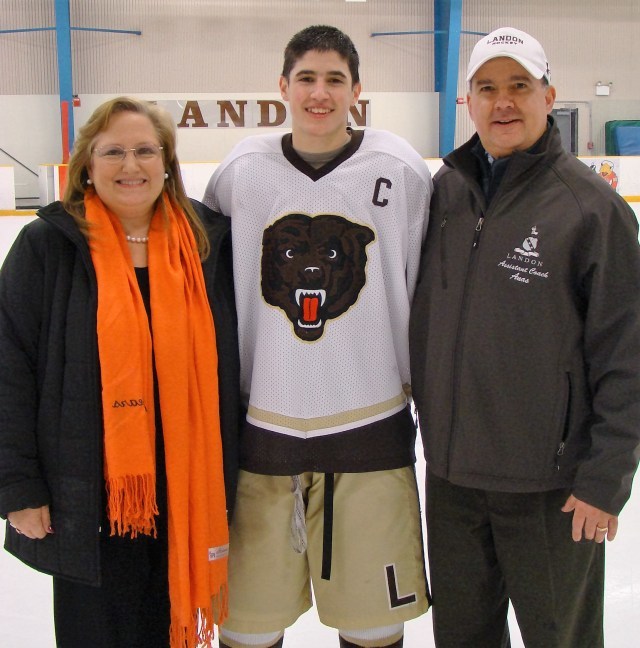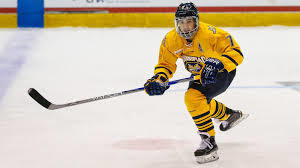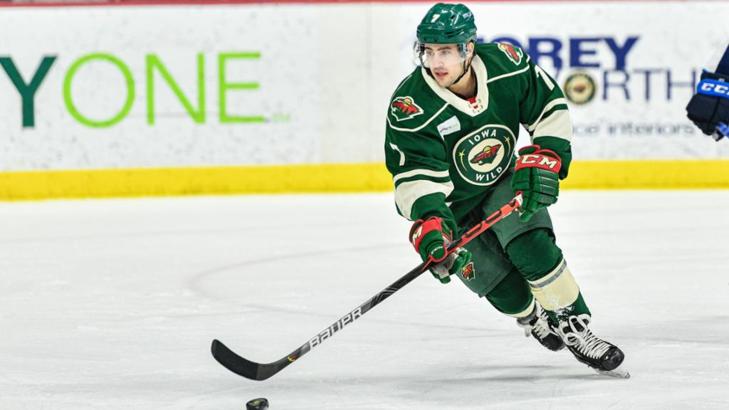Pathways to Success - Sam Anas
This is the first of an ongoing series that will focus on hockey players from the DMV and the various pathways they have taken in advancing to the NCAA level or beyond.
By Scott Lowe – DMVProspects.com
 One thing I emphasize when I meet with young players and their families is that every pathway for a player toward achieving his or her hockey goals is different.
One thing I emphasize when I meet with young players and their families is that every pathway for a player toward achieving his or her hockey goals is different.No matter how much I try to help local families with the educational and decision-making process, though, there are people in the area who have gotten angry with me, saying that I encourage local players to leave home.
That is 100 percent not the case. In fact, it’s an absolutely ridiculous assertion by some folks who would be much better off promoting their own players instead of pointing fingers at someone who is doing what they should be doing.
My sole purpose is to help as many kids as I can do what my son has done and advance to play hockey at the NCAA level. Why would I encourage kids to leave home when my son chose to play his entire youth career in the DMV area, graduate from high school and then pursue juniors?
He had opportunities to leave, despite only having played at the AA level to that point, when he was 15 and 16 years old. At that stage of his life, from a maturity standpoint, Devin was not ready to move away. Could he have ended up playing at the Division I level instead of D3 had he moved to New England to play AAA or prep-school hockey when he was 15 or 16? It’s possible, but the odds were still very much against that happening.
That’s not because he wasn’t good or good enough. There are only about 150 colleges and universities that sponsor NCAA hockey at any level, and 62 of those are D1 programs. Compare that to the more than 300 NCAA D1 basketball programs alone to understand that the quality of NCAA hockey at all levels is very high.
That fact is that Devin still very well may be good enough to play at the D1 level, and he did draw some Division I interest over the years. The reality is, especially for kids from our area, that the odds are very much against anyone playing NCAA Division I hockey. My approach is to maximize a young player’s odds of playing at the highest level he or she is capable of reaching while also being supportive AND realistic.
The most important factor when it came to Devin’s decision to finish his youth hockey career at home, though, was that HE didn’t want to leave, and as a family we weren’t ready to let him go. We didn’t feel it was in his best interest socially or academically, but first and foremost, he simply wanted to play hockey at the highest level he could here while finishing school with his buddies.
That doesn’t mean what Devin wanted is what every young player wants or that his path is the only one to take.
Some kids are emotionally, socially and academically prepared to leave home and can’t get away fast enough. If that’s the case, a young player’s odds of getting the exposure, coaching and experience necessary to advance to the NCAA level might be increased by heading north to attend a prep school or play AAA hockey. If that plan of action fits into a family’s budget – and the parents are okay losing those years with their child to help him or her realize dreams – that is a great route to choose, and I am more than happy to assist in that process,
Devin made every single hockey decision along his pathway to college hockey. I provided as much information for him as possible allow him to make the best decision for himself, and although I didn’t agree with every choice he made, they all turned out to be good decisions that helped him accomplish his goals.
 When you don’t allow the kids to do what they prefer, you run the risk of them not buying into the process or losing interest if things go the least bit sideways. I see far too many parents pushing and rushing without understanding the process, which often leads to bad or uneducated decisions and players who don’t reach their potential or just flat-out give up.
When you don’t allow the kids to do what they prefer, you run the risk of them not buying into the process or losing interest if things go the least bit sideways. I see far too many parents pushing and rushing without understanding the process, which often leads to bad or uneducated decisions and players who don’t reach their potential or just flat-out give up.I also see too many parents nodding and smiling – or liking my Tweets – but still not listening when I tell them they shouldn’t spend all kinds of money on combines and main camps, don’t have to push their kids to AAA too soon, shouldn’t just send their kids away for hockey without considering the potential fallout if things don’t go well, not to send their kids to juniors too soon and many other things.
My son was told by a 16U AAA coach that his “career would be finished” if he didn’t play for his team that year. That statement turned Devin off and came off as very high-pressure. He chose not to play for that coach, although he liked him, because that comment did not sit well. And he used it as motivation.
No one’s career is over at age 15, 16 or 17. There are so many potential pathways to junior and college hockey that parents need to stop panicking for their kids when they are that age and something doesn’t work out. Parental pressure and tension only stresses young players out, causes them to put undue pressure on themselves and sometimes pushes them to make decisions that aren’t in their best interest developmentally.
If the player doesn’t love his or her team and hockey situation, regardless of what level they’re at, the likelihood of them putting in the extra work to get to whatever level they hope to achieve is extremely unlikely.
Please realize that there are tons of options out there. Not every kid is a fit for every coach and style of play. When one door closes, many others usually open. If a coach cuts you, whether you think you deserve to be on the team or not, it probably wasn’t going to be a good fit even if you were good enough.
As I’ve written before, don’t get caught up in alphabet soup. Playing AAA hockey for a coach who doesn’t fully believe in you as a fourth-liner who may not play in the third period of close games likely is not as good for your development as being a top player who plays in all situations on a AA team for a coach who will make you better.
These days many AA tournaments are scouted, and even if the exposure isn’t as good as it is at the AAA level, there are plenty of opportunities to be seen by the right people in the spring and summer. One of the main reasons I offer showcase teams is to help deserving young players who might have ended up on a less-visible team get in front of the right people who can provide higher-level opportunities in the future.
For the parents reading this, always do your homework. Find a coach with the right personality for your child; you can only do that by allowing the player to interact with the coach (without YOU driving the interactions) and figure out if it’s a personality fit. Look for a program that develops players and moves them on to higher levels. Talk regularly as a family and determine what potential options are favorable in terms of the coach, the program’s track record, the player’s likely role, the financial commitment required, the player’s short- and long-term goals and the location.
Make sure the child is comfortable with the decision and comes to that conclusion without you pushing him or her in that direction. Some of the true answers only can be found if parents take a few steps back and let their children start figuring out what THEY like and what THEY prefer. It’s the player who has to live with the decision, work with the coach and put in the time and effort to keep progressing.
That has to come from inside, not as a result of parental pressure. Motivation, drive and desire has be internal and cannot be manufactured. This has to be what the kids want, not what the parents want.
So, for any parents reading this, after years of trying to communicate this politely, I think it’s time to be blunt.
Stop communicating for them. NOW.
Stop asking 50 people the same questions until you hear what you want to hear. NOW.
Stop taking constructive criticism made by coaches and scouts personally. NOW. Young players need that feedback to grow.
Stop sending and reading their emails. NOW.
Stop filling out registration forms and questionnaires for them. NOW.
Stop putting your email address and cell phone number as theirs when they register for tryouts, camps and events. NOW.
Stop saying you understand while continuing to do these things. NOW.
The only way this works is to allow them to find their way, with your guidance and support, of course. But you can’t do it for them. They have to figure out what’s best for them and what they want.
The good news is that every door that closes almost always does lead to another one that opens. There are no dead ends. Many players have been told they can’t or aren’t good enough by one team or coach only to find the right fit somewhere else and flourish.
Enjoy the journey and the extra family time it brings that so many families don’t get to have instead of stressing out over every bad bounce, shortened shift, negative comment, missed opportunity and bad break.
Support.
Encourage.
LISTEN.
Learn.
Be a sponge and soak up as much information as you can so that you can be part of the process, but also be willing to let your child drive the boat.
If you can handle that as a parent, together we can find a pathway that will take a player as far as he or she can go and provide him or her with opportunities that will lead to happiness and allow the player to develop into a successful adult with much to contribute to society.
God knows we need more of that right now.
So, with that message in mind, during the weeks and months ahead we are going to highlight players who have grown up locally, played the majority of their careers in the DMV and progressed to the NCAA level or beyond. The point of these profiles is for families to see just how many different paths are available and the various twists and turns that often accompany those journeys.
First up, Sam Anas:
Sam Anas – Forward – 1993 birthyear – Potomac Maryland
 Sam most recently participated in the Minnesota Wild’s NHL postseason Phase 3 training camp. Despite leading the American Hockey League in scoring this season while playing for the Iowa Wild, he was left off Minnesota’s final 31-player postseason roster. Sam had 20 goals and 50 assists in 63 AHL games this year.
Sam most recently participated in the Minnesota Wild’s NHL postseason Phase 3 training camp. Despite leading the American Hockey League in scoring this season while playing for the Iowa Wild, he was left off Minnesota’s final 31-player postseason roster. Sam had 20 goals and 50 assists in 63 AHL games this year.Sam has spent the last four years playing for Iowa after signing with the Wild organization as a free agent out of Quinnipiac University. This year he was named a first-team AHL All-Star and led the league in assists as well as points to receive the John B. Sollenberger Trophy.
At Quinnipiac, Sam served as an assistant captain his junior year, leading the team to the Frozen Four and being named a Hobey Baker Award finalist. The Hobey Baker award is presented annually to the top player in all of NCAA Division I hockey. It is hockey’s equivalent of the Heisman Trophy.
He had 24 goals and 26 assists that season. Sam won the Tim Taylor award as the top NCAA rookie for 2013-14 and also was the ECAC Rookie of the Year and a second-team All-ECAC selection. He was a second-team All-American as a sophomore and a first-team selection as a junior.
Sam grew up in the DMV area and played locally all the way through his second 18U season. He played for both Team Maryland and the Little Caps during his youth hockey career and also for the Landon School. During his second 18U season Sam also played for the D.C. Capitals, a TM and Little Caps hybrid that competed in the NAPHL during the 2010-11 season. Between the AYHL and NAPHL that year he recorded 82 points in 44 contests.
With just two years of junior eligibility remaining, Sam was drafted by the Youngstown Phantoms in the second round, 22nd overall, of the 2011 USHL Draft. He says that his adjustment to junior hockey was challenging and that he had to fight his way up the lineup from a bottom-six position. Sam didn’t play every game his first year in Youngstown, appearing in 51 contests and recording 34 points. He played in 64 games the following year, posting 37 goals and 26 assists, but still didn’t get much NCAA Division I attention.
Standing but 5-foot-8 and weighing 165 pounds, his only solid D1 offer was from Quinnipiac; he signed there, and the rest is history.
"If you ask me from when he was 18, no question, he's completely exceeded what we thought he would be," Rand Pecknold, Sam's coach at Qunnipiac told the Hartford Courant. "We thought he could be pretty good, but there was a lot of risk when we took him in terms of his size. Then [after two years at Youngstown] we were like, 'Oh, this is looking really good.' At that point we knew we had a top-six forward, a power play guy. But even then, did we think he had a shot at being an All-American?"
